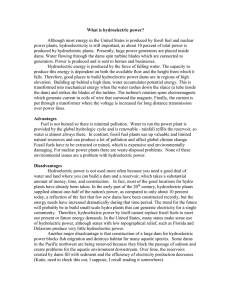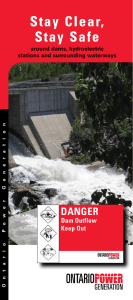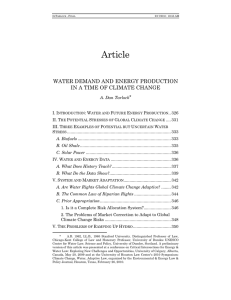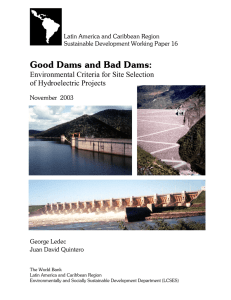Celine - Chemistry Powerpoint
advertisement
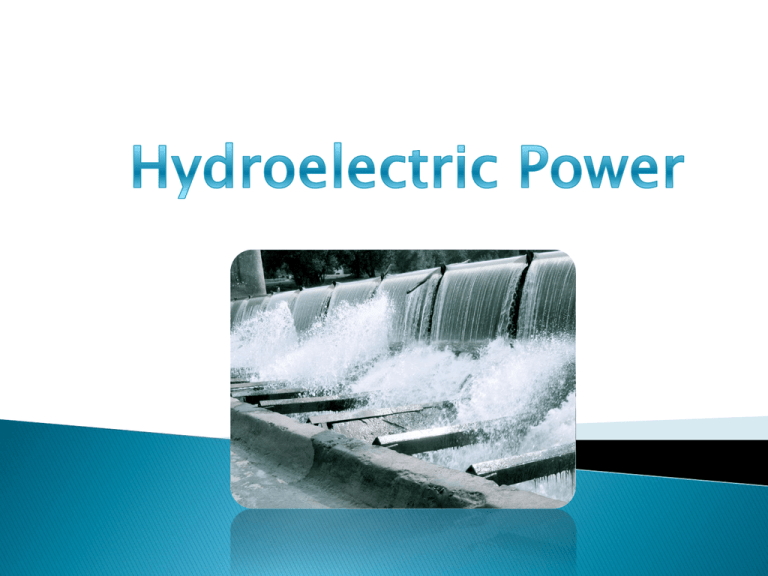
Hydroelectric power is generated by the force of falling water. It’s one of the cleanest, reliable and least expensive source of energy. A dam is built, then the water is held behind the dam. The force of the water being released from the reservoir through the dam causes the blades of the turbine to spin. The turbine is connected to the generator which makes the electricity as it spins. After passing through the turbine, the water flows back into the river on the other side of the dam. No fuel required. This means that the cost is cheaper because that cost is not depending on the price of fuels and there is no need to import fuel. There is no air-pollution created and does not emit any harmful gases. These plants last a long time, once one is built it can function from 50 to 100 years and longer. The operating costs are cheaper because the plants require less employees due to the fact that most of the operations are automated. The plants work easily throughout the peak periods. The plants can be easily started and stopped with little time. The dams built prevent floods in nearby areas. Water from these dams can also be used to irrigate farmlands even in areas where there is little or none rainfall. Disrupts the water life. The dams may interfere with the mating season and also some fish may get caught in the turbines and die. Disrupts the surroundings. In some cases many trees have to be cut down and areas cleared which disrupts the animal life that depends on the trees. Requires large areas. Requiring larger areas means more disruption to the surrounding animals and forests. Some people are forced to leave their homes and their land in order for these plants to be built. These people are also not given any proper remuneration or resettlement. Expensive in cost to build these plants and takes a lot of time to construct one as well. Also, if the dams aren’t constructed proper it could break causing many deaths.(human and animal lives) Some alternatives for Hydroelectric power are: Solar energy Geothermal energy Wind energy Tidal energy Ocean wave energy Storage Reservoir–Stores the dammed water Dam Structure–Dams the water Sluice Gates–Controls the water flow Penstock–Tunnel leading the water to the turbines Turbines–Turns the generators when water flows through Generators–Produces the electricity when turned by the turbines Transformers–Transfers the produced electricity to the electricity grid http://www.darvill.clara.net/altenerg/hydro.htm http://hubpages.com/hub/advantages-hydroelectric-power http://www.brighthub.com/environment/renewableenergy/articles/7728.aspx http://www.brighthub.com/environment/renewableenergy/articles/7729.aspx http://www.darvill.clara.net/altenerg/hydro.htm http://www.technologystudent.com/energy1/hydr2.htm http://www.brighthub.com/environment/renewableenergy/articles/7730.aspx http://www.google.ca/search?hl=en&biw=1020&bih=567&defl=en&q=def ine:Hydroelectric+Power&sa=X&ei=3jwJTanfBorU4gaTx9SIAQ&ved=0CBg QkAE http://www.wisegeek.com/what-is-hydroelectric-power.htm http://www1.agric.gov.ab.ca/$department/deptdocs.nsf/all/eng4431 http://www.top-alternative-energy-sources.com/hydroelectricpower.html



